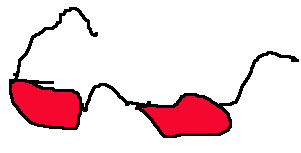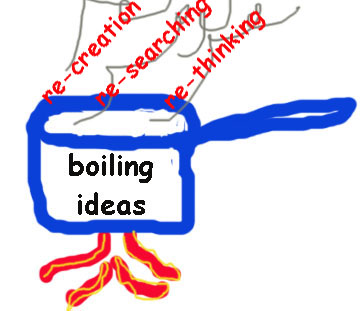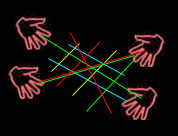Welcome to our first message from Advisory Board Members. This particular message is in the form of a conversation between two of our board members, Nobuyuki Ueda, Professor of Education at Konan Women's University in Kobe, Japan and director of the neoMuseum in Nara, Japan and Hillel Weintraub, Director of the Communication Center at Doshisha International Jr/Sr High School and lecturer in Media in Life and Learning at Doshisha Women's University in Kyoto, Japan. Nobuyuki and Hillel have recently had two exciting co-workshops/presentations: one in Tokyo in the NewSchools Series and the second at the Doors of Perception, 1998 Conference on PLAY in Amsterdam.
Hillel: This is a great chance to share some of our ideas about learning and young people. I'm particularly interested in the idea of redefining concepts - trying to see them in a new way, breaking constraints. So we've named one of the areas on the new CRN site, r&r cafe - researching and rethinking cafe. I like the way this name puts the emphasis on "RE" - doing something anew! Usually we don't think about "researching" as "re" + "searching", but that's a powerful idea, isn't it? Searching again with new eyes.
 Nobuyuki: Yes. I'm very excited about opening this new site, too. I especially like the metaphor of r&r cafe, for creating a new research culture about children. Cafe implies a place where people can create a new culture and cozy environment for discussing and rediscussing - narrating and re-narrating - casting and recasting, our thoughts and feelings. I'm sure you also like to be in a cafe to talk to and meet many people.
Nobuyuki: Yes. I'm very excited about opening this new site, too. I especially like the metaphor of r&r cafe, for creating a new research culture about children. Cafe implies a place where people can create a new culture and cozy environment for discussing and rediscussing - narrating and re-narrating - casting and recasting, our thoughts and feelings. I'm sure you also like to be in a cafe to talk to and meet many people.
H: Sure, it's a feeling of really relaxed, but meaningful communication! I remember talking to you maybe 5 years or so ago and you had just created some kind of learning cafe - maybe at the neoMuseum. After that, at my school we created an area called the Communication Cafe, as a part of a complex of many communication spaces.
N: I wanted to change people's image from school-like learning where someone is teaching something, to an open air cafe where all participants can converse.
H: Right! The traditional image of a classroom is like a one-way food stuffing place. a cafe's lively, give and take mood, with everyone choosing for themselves what they want to eat and drink is a totally different environment. This brings up another learning metaphor that you use quite a lot, too - cooking!
N: Yes, cooking is really a "social constructionist" activity. When I discuss constructivist learning environments, I use the metaphor of cooking a lot.
H: It's so completely different from the idea of just passive learning where one person gives an idea to someone - but cooking and eating and re-cooking and re-eating - tasting and talking, a lot of reflection and debugging is going on.
N: In this kind of environment, no one is an observer - everyone becomes a player!
H: This really fits in with the kind of workshops and classes that you and I have been holding recently - trying to create a new mood, a new way of designing learning spaces and activities which create a new way of people interacting together.
N: It's a new ecology of learning, or I could say an emergent learningscape.
H: Emergent meaning that particular kinds of activities are likely to happen naturally or improvisationally?
N: Yes, the heart of the word "emergent" is life or energy. The learning environment itself has a living spirit.
H: I don't know if I get your image clearly. You mean something that emerges grows out of a living situation, not a prepackaged curriculum or a plan that someone comes in with and says, "Okay, now we're going to cover pages 1-5" and then proceeds to go step by step through a text? There's no mystery, no surprise, no life there. Is this something like what you're talking about?
N: Yes, an emergent learning space is really  a situated design, not preplanned.
a situated design, not preplanned.
H: Can you say more about "situated design?"
N: When I'm getting ready for some interaction, of course I think and plan ahead very carefully and prepare artifacts to support activities, but once that interaction begins, I like to pay more attention to the natural, boiling energy that emerges from that environment.
H: Sometimes, when someone asks me, how long did you prepare for that class or that workshop, I answer, "My whole life." Of course, we prepare specific things for each situation, but it's more designing for possibility than for actual sequence. This allows us to interact with people and observe their responses and react to them.
Let me jump here a bit. How can we relate some of these ideas we've been talking about to traditional styles of doing research, which in some ways, seems very static. You know in graduate schools and other facilities, there are a lot of people doing research. But it gets done, then written in some form and put on a shelf. Some people read it, but it usually stays in that original form forever. I really want to bring these new ideas into the research field - you know - something like boiling, emergent research!
N: If I come up with a very interesting idea about children, I'd like to talk to a couple of people and co-construct new perspectives about the topic. I'd like to bring some seed and see how other people see it and how we can help it grow together. Or, to go back to the cooking metaphor, a research environment is like a chef's kitchen. we cook together, bringing in a lot of fresh ideas. It's a joint cooking venture, a co-construction of knowledge. This is really an attitude of research.
H: Yes, I think this is what I'm getting at. It's really re-defining our idea of research and children and research with children, rather than research ON children. And this idea of involving others in a conversation about something. This is a vibrant kind of research that I'd really like to see come to life here at this CRN site.
N: We'd like to go beyond a kind of traditional concept of research and the image of child and we are very happy if we can use the cafe as a place to start.
H: Let me bring in some thinking I've been doing recently about the meaning of "child". Since a year ago when I started working with CRN, I've had some discomfort with the way this organization used the word "child" in their name- "Child Research Network". When I was first asked to be a part of their group, I thought, "Why? I don't really work with children?" I was surprised to learn the CRN was doing work with students through high school age, not just pre-teenagers. To me, "child" has the image of a young person, perhaps through elementary school, and it was my assumption that most middle and high school students would not welcome being called a "child" or being thought of as "children." In my own youth, I always bristled if anyone referred to me as a child once I had moved into my teens. One of my American colleagues at work sometimes referred to his high school students as "children." I told him I thought this was inappropriate, and even insulting.
N: I understand your feeling toward the word children, but for me "children" sounds educational - like "children's museum" sounds like an learning place for children. And for me "children" isn't so much age-related, but it's a kind of heart or spirit of creating something exciting.
H: That's interesting. Your concept is quite different; I found out that there are so many ways of thinking about this. Last April, I became involved with the Jr. Summit II Project that is being sponsored by the Media Lab at MIT (Massachusetts Institute of Technology) in Boston. This project is focused on kids aged 12- 15. Some of their literature also uses the term "children". I asked Media Lab professor, Justine Cassell who is in charge of this project, if there had been any discussion about the use of this word "child". She told me that there had been some concern raised about using the world "children" to refer to teenagers and also that this had been raised in discussion with Media Lab Professor Seymour Papert. Seymour asked her to think why kids should feel strange about being referred to as children? What was there about the word that bothered young people. Why not start a child pride movement? This perspective of Seymour's really shook up my assumptions and opened my mind to new ways of thinking. Indeed I felt that I should do some re-searching into the whole question.
N: This seems like a good opportunity to do the kind of collaborative research we were talking about. Maybe starting to talk to other people about some of these questions.
H: Yes, I think trying to explore some of these ideas from intercultural perspectives could be very mind opening. Bringing more people into the conversation, we could develop our awareness that the meaning of "child" isn't in the word or the sounds, but in the people who use the word and how we use it. You know, when I was a kid, I always heard expressions like, "Don't be so childish!" or "Grow up!" or "You're so immature!" used as ways of telling children that their way of acting or thinking wasn't approved by the culture in power. "Child" was always dichotomized with "sensible", "powerful", "correct". So it was quite natural for me to feel that this was a term that I wanted to remove myself from as soon as possible.
Did you have similar feeling about being a "kodomo", Nobuyuki?
N: (laughing)I'd like to be a "kodomo" forever.
H: That's great! I have this feeling too, now, but when I was a teenager, I really didn't want to be thought of as a child. Was that your perspective as a teenager too?
N: When I was a teenager, I wanted to see what was going on in the adult society. I felt it was a broader world. To become an adult meant to be able to enter into a broader world.
H: That's interesting because now that I'm a member of this "adult" world, I see exactly how stiff and restricted our thinking is compared with children's!
N: Yes, I've definitely found more constraints in this so-called adult world.
H: I thought it would be interesting to find out what some Japanese kids thought about the term, "Child" or "Kodomo" so I conducted a mini-research project which would give kids a chance to express some of these feelings. You can see some of the data, both pictures and words, that I've gathered in the r&r cafe in the poster sessions section, "What's a Child?"
N: That sounds interesting, I'll check it out! . . . Going back to the new website of CRN, I think using a space metaphor is very important - whether we use the metaphor of teaching classroom or artists studio or atelier.
H: it really changes the way we see ourselves and what we're doing.
N: that's why we created this new cafe on the CRN website. we want to create a brand new cyber-cafe! We want everyone to join and to create the mood of the cafe. We're not really providing the mood, but we're asking people to create this together, to co-construct this cafe.
H: co- is another important idea that we've been using a lot, just like re-. Co-designing, co-learning.
 N: Especially co-constructing our experiences together on the www; it's one of the great challenges for us here. People can really bring a lot of brave and surprising ideas into play.
N: Especially co-constructing our experiences together on the www; it's one of the great challenges for us here. People can really bring a lot of brave and surprising ideas into play.
H: Play! That's another theme we've been "playing" with. A cafe is a pretty playful place, too. I mean a lot of serious things can be done here - maybe some revolutions have been planned in cafes, but it's still a playful place.
N: we could call it a playful learning - or learningful play. We like to see learning as play and play as learning - not as separate things.
H: this brings us to the idea of some dichotomies that can get in the way of playful thinking. so lots of people dichotomize learning and play, just as a lot of people dichotomize child and adult.
N: in the same way, we can rethink the concepts child and adult. This is one of the purposes of creating r&r cafe. discussing these important issues. Like this conversation we're having - I'm really enjoying talking with you right now.
H: Me too.
N: This is my image of this new site - everyone talking freely and stimulating each other. Let's have a jazzy improvisation talk. And we can learn musically. I like the word "musically" relating to everyday life spirit.
H: Well, we've been talking about dancing as a metaphor for learning together, so music is really important in this metaphor, too.
N: Let's try to have a cognitive and affective dance. I like the words, cognitive dance or affective or emotional wave. So let's dance together on the CRN website.
H: Let's post a sign in cyberspace!















